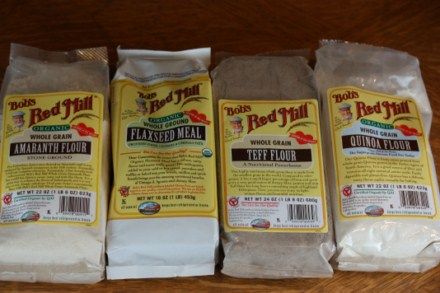A few months ago I shared that one of my goals for this year was to experiment more with healthier gluten free flours and so far I have used them quite a bit.
However, I still have mixed feelings about them and so far I have not had a recipe that I feel is worth sharing. I did make the quinoa crepes, which my family loved, but besides that I am still working on getting the right ratio of how much of these flours to add to recipes.
I have experimented with adding them to my pancakes, waffles, homemade pizza crust, and a few other things. I am finding that there is a fine line in most things between adding enough to make them healthier and not so much that the taste is over powering and the texture suffers.
I love my gluten free baked goods to taste close to the real thing. That is one of my goals with gluten free baking. If I can make a gluten free muffin, pancake, or other item taste so good that my family cannot tell the difference I am very happy.
Before I was gluten free I used a lot of whole wheat flour, so my family is used to eating healthier whole grains, but I am finding that the teff, amaranth, and quinoa flours have a much stronger taste than whole wheat flour. They also make for a much heavier end result and they end up tasting much different than the original version.
I am not giving up though. I am going to continue to experiment with them and will continue to work on coming up with some healthier versions of our favorite gluten free foods.
I would love to hear any tips you have for using the healthier gluten free flours. What are your thoughts about them?


I find that the flours work well substituted by weight in most recipes calling for a brown rice flour, in relatively small quantities. A kitchen scale is really helpful here (and Bob’s Red Mill prints the weights of the flours with the nutritional info, so it’s pretty easy).
The flavors of the “healthier” gf flours can be a bit overwhelming to foods, so start slowly would be best tip. Flaxseed meal is different than the flours though, so I usually just add a couple of tablespoons per recipe to add a nutty flavor.
Of the flours you have pictured, I like Teff the most; it has a sweet, molasses like flavor that is great in gluten-free baked goods like gingerbread, graham-type crackers, and pancakes.
I have had good success with using 2 parts buckwheat flour, 1 part quinoa flour (ground from quinoa flakes), 1 part brown rice or sorghum flour. It tastes pretty similar to baked goods with whole wheat flour.
I grind my own buckwheat flour from hulled buckwheat groats. I like using quiona flakes because it has been rinsed before before rolled so the bitter taste is not present. The flakes are very easy to grind in your spice or coffee grinder or blender.
Hi, I recently purchased Elizabeth Hasselbeck’s new book, Deliciously G-Free: Food So Flavorful They’ll Never Believe It’s Gluten-Free. I have not yet tried any of the recipes but the name of the book and her introduction have convinced me that her versions are worth trying!
I have not seen that book, but I will have to look for it.
If you haven’t tried King Arthur Flour’s gluten-free line, you should really give it a try. I’ve been baking GF for family members for over 15 years with various combinations of specialty flours and this stuff is the best I’ve worked with… tastes closest to the wheat counterparts. Not sure if you would consider their basic mixes healthier, but they do have a line of “ancient grains” that I’m eager to try in the bread recipe now that I have the hang of the standard recipe. (Been using this product line for a couple of months)
I have tried several KA mixes and I agree they are great. I also love the recipes on their site and they homemade recipe for their blend. They are all really good. I have not tried their ancient grains blend, but it looks really good.